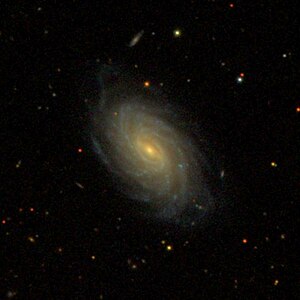NGC 2619
| Galaxy NGC 2619 |
|
|---|---|

|
|
| SDSS recording | |
| AladinLite | |
| Constellation | cancer |
|
Position equinox : J2000.0 , epoch : J2000.0 |
|
| Right ascension | 08 h 37 m 32.7 s |
| declination | + 28 ° 42 ′ 19 ″ |
| Appearance | |
| Morphological type | Sbc / Seyfert 2 |
| Brightness (visual) | 12.6 mag |
| Brightness (B-band) | 13.4 mag |
| Angular expansion | 1.8 ′ × 1.1 ′ |
| Position angle | 35 ° |
| Surface brightness | 13.2 mag / arcmin² |
| Physical data | |
| Affiliation | isolated |
| Redshift | 0.011588 ± 0.000023 |
| Radial velocity | 3474 ± 7 km / s |
|
Stroke distance v rad / H 0 |
(153 ± 11) · 10 6 ly (46.9 ± 3.3) Mpc |
| history | |
| discovery | William Herschel |
| Discovery date | March 12, 1785 |
| Catalog names | |
| NGC 2619 • UGC 4503 • PGC 24235 • CGCG 150-008 • MCG + 05-21-002 • IRAS 08345 + 2852 • 2MASX J08373272 + 2842187 • GC 1676 • H II 319 • h 514 • GALEX ASC J083732.56 + 284218.4 | |
NGC 2619 is a bar-spiral galaxy with an active nucleus of the Hubble type SBbc in the constellation Cancer on the ecliptic . It is an estimated 153 million light-years from the Milky Way and about 80,000 light-years across.
The galaxy NGC 2608 is located in the same area of the sky .
The object was discovered by Wilhelm Herschel on March 12, 1785 .
Web links
Commons : NGC 2619 - collection of images, videos, and audio files
